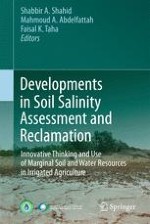2013 | OriginalPaper | Chapter
38. Integrating Agroforestry and Pastures for Soil Salinity Management in Dryland Ecosystems in Aral Sea Basin
Authors : K. N. Toderich, E. V. Shuyskaya, Faisal K. Taha, Naoko Matsuo, Shoaib Ismail, D. B. Aralova, T. F. Radjabov
Published in: Developments in Soil Salinity Assessment and Reclamation
Publisher: Springer Netherlands
Activate our intelligent search to find suitable subject content or patents.
Select sections of text to find matching patents with Artificial Intelligence. powered by
Select sections of text to find additional relevant content using AI-assisted search. powered by
